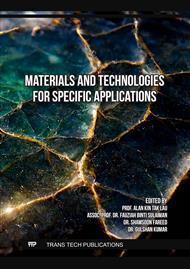[1]
Ahmed, R., Hamid, A. K., Krebsbach, S. A., He, J., & Wang, D. (2022). Critical review of microplastics removal from the environment. In Chemosphere (Vol. 293). Elsevier Ltd
DOI: 10.1016/j.chemosphere.2022.133557
Google Scholar
[2]
Andrady, A. L. (2011). Microplastics in the marine environment. In Marine Pollution Bulletin (Vol. 62, Issue 8, p.1596–1605)
DOI: 10.1016/j.marpolbul.2011.05.030
Google Scholar
[3]
Hale, R. C., Seeley, M. E., La Guardia, M. J., Mai, L., & Zeng, E. Y. (2020). A Global Perspective on Microplastics. In Journal of Geophysical Research: Oceans (Vol. 125, Issue 1). Blackwell Publishing Ltd
DOI: 10.1029/2018JC014719
Google Scholar
[4]
Huang, S., Wang, H., Ahmad, W., Ahmad, A., Vatin, N. I., Mohamed, A. M., Deifalla, A. F., & Mehmood, I. (2022). Plastic Waste Management Strategies and Their Environmental Aspects: A Scientometric Analysis and Comprehensive Review. In International Journal of Environmental Research and Public Health (Vol. 19, Issue 8). MDPI
DOI: 10.3390/ijerph19084556
Google Scholar
[5]
Ingelsson, M., Yasri, N., & Roberts, E. P. L. (2020). Electrode passivation, faradaic efficiency, and performance enhancement strategies in electrocoagulation—a review. In Water Research (Vol. 187). Elsevier Ltd
DOI: 10.1016/j.watres.2020.116433
Google Scholar
[6]
Irfan, T., Khalid, S., Taneez, M., & Hashmi, M. Z. (2020). Plastic driven pollution in Pakistan: the first evidence of environmental exposure to microplastic in sediments and water of Rawal Lake. Environmental Science and Pollution Research, 27(13), 15083–15092
DOI: 10.1007/s11356-020-07833-1
Google Scholar
[7]
Mukheed, M., & Khan, A. (2021). Journal of Pollution Effects & Control Plastic Pollution in Pakistan: Environmental and Health Implications Article in Journal of Pollution Effects & Control ·
Google Scholar
[8]
Qaiser, N., Sidra, S., Javid, A., Iqbal, A., Amjad, M., Azmat, H., Arooj, F., Farooq, K., Nimra, A., & Ali, Z. (2023). Microplastics abundance in abiotic and biotic components along aquatic food chain in two freshwater ecosystems of Pakistan. Chemosphere, 313
DOI: 10.1016/j.chemosphere.2022.137177
Google Scholar
[9]
Saleem, M., Bukhari, A. A., & Akram, M. N. (2011). Electrocoagulation for the treatment of Wastewater for reuse in irrigation and plantation (Report) Electrocoagulation for the Treatment of Wastewater for Reuse in Irrigation and Plantation. Article in AUSTRALIAN JOURNAL OF BASIC AND APPLIED SCIENCES, 7(1). https://www.researchgate.net/publication/228481990
DOI: 10.7176/jnsr/11-24-04
Google Scholar
[10]
Senathirajah, K., Kandaiah, R., Panneerselvan, L., Sathish, C. I., & Palanisami, T. (2023). Fate and transformation of microplastics due to electrocoagulation treatment: Impacts of polymer type and shape. Environmental Pollution, 334
DOI: 10.1016/j.envpol.2023.122159
Google Scholar
[11]
Shen, M., Zhang, Y., Almatrafi, E., Hu, T., Zhou, C., Song, B., Zeng, Z., & Zeng, G. (2022). Efficient removal of microplastics from wastewater by an electrocoagulation process. Chemical Engineering Journal, 428
DOI: 10.1016/j.cej.2021.131161
Google Scholar
[12]
Yang, X., Man, Y. B., Wong, M. H., Owen, R. B., & Chow, K. L. (2022). Environmental health impacts of microplastics exposure on structural organization levels in the human body. In Science of the Total Environment (Vol. 825). Elsevier B.V
DOI: 10.1016/j.scitotenv.2022.154025
Google Scholar
[13]
Zaied, B. K., Rashid, M., Nasrullah, M., Zularisam, A. W., Pant, D., & Singh, L. (2020). A comprehensive review on contaminants removal from pharmaceutical wastewater by electrocoagulation process. In Science of the Total Environment (Vol. 726). Elsevier B.V
DOI: 10.1016/j.scitotenv.2020.138095
Google Scholar


